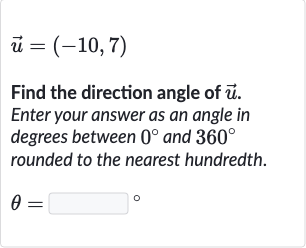Full solution
Q. Find the direction angle of . Enter your answer as an angle in degrees between and rounded to the nearest hundredth.
- Calculate Tangent Ratio: To find the direction angle of the vector , we need to calculate the angle that the vector makes with the positive x-axis. The direction angle, often denoted as , can be found using the arctangent function ( or ), which gives us the angle whose tangent is the ratio of the y-coordinate to the x-coordinate of the vector.
- Use Arctangent Function: First, we calculate the tangent of the angle using the coordinates of . The tangent of is the ratio of the y-coordinate to the x-coordinate:
- Determine Quadrant: Next, we use the arctangent function to find the angle whose tangent is . We must be careful to place the angle in the correct quadrant. Since the x-coordinate is negative and the y-coordinate is positive, lies in the second quadrant, where the direction angles are between and ..
- Calculate Direction Angle: Using a calculator, we find that: .However, this angle is measured from the positive x-axis in the clockwise direction. To find the direction angle between and , we add to this angle because it is in the second quadrant..
- Round to Nearest Hundredth: We round the direction angle to the nearest hundredth as requested: .
More problems from Inverses of sin, cos, and tan: degrees
QuestionGet tutor help
QuestionGet tutor help
QuestionGet tutor help
QuestionGet tutor help
QuestionGet tutor help
QuestionGet tutor help
Question
. Find the value of in degrees.Write your answer in simplified, rationalized form. Do not round.____
Get tutor helpQuestionGet tutor help

